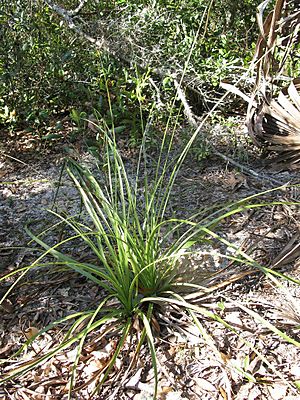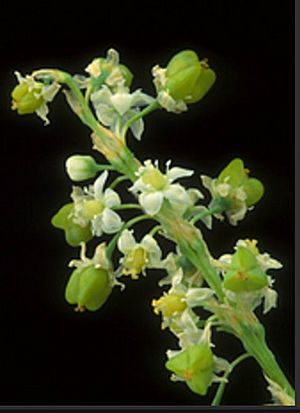Britton's beargrass facts for kids
Quick facts for kids Britton's beargrass |
|
|---|---|
 |
|
| Conservation status | |
| Scientific classification | |
| Genus: |
Nolina
|
| Species: |
brittoniana
|
Britton's beargrass (scientific name: Nolina brittoniana) is a special and rare flowering plant. It belongs to the asparagus family. People often call it beargrass because its leaves look like grass.
This plant is found only in Florida, which means it is endemic to that state. There are 72 known groups of these plants, but only a few are large enough to survive well. Because it is so rare, the United States government has listed it as an endangered species. This means it is protected by law to help it survive.
Contents
What Britton's Beargrass Looks Like
This plant grows close to the ground. It doesn't have a stem that stands up above the soil. Instead, its leaves grow in a circle, like a rosette. These leaves are attached to a bulb-like base. This base comes from an underground caudex, which is a special kind of stem.
The leaves look like grass. They can grow up to one meter (about 3 feet) long. But they are usually less than one centimeter (less than half an inch) wide. The edges of the leaves have small, tough teeth.
Flowers and Seeds
The plant produces a tall flower stalk called an inflorescence. This stalk can also grow up to one meter tall. It has many small flowers. Each flower has tiny petals, only about 1 or 2 millimeters long.
Even though the flowers have both male and female parts, they usually only work as one or the other. Most plants have either mostly male or mostly female flowers. But some plants have both. Britton's beargrass blooms from March through May. After blooming, the flowers turn into winged seed pods. These pods are about one centimeter long and wide.
The plant can make new plants in two ways:
- It can grow from seeds.
- It can also grow new plants by cloning itself. This means new plants grow directly from the parent plant.
Where Britton's Beargrass Lives
This special plant lives in only seven counties in Central Florida. It grows in different types of habitats there. You can find it in:
- Various kinds of Florida scrub habitat
- Hammocks
- Sandhills
All these places are different, but they share some things in common. They all have dry, sandy soils that don't have many nutrients. Also, these habitats need wildfire to stay healthy.
Britton's beargrass is often found on the Lake Wales Ridge. This area is home to many other rare plants that are unique to Central Florida. It grows near other interesting plants like Polygala lewtonii and Liatris ohlingerae.
Why Britton's Beargrass is Endangered
Britton's beargrass lives in plant communities that depend on natural fires. Wildfires are important because they stop large trees and shrubs from growing too much. This keeps the forest open and allows sunlight to reach the smaller plants on the ground. Without fire, the habitat changes.
For a long time, people tried to stop all wildfires. This policy of fire suppression has hurt the beargrass's habitat. Without fire:
- The habitat becomes overgrown.
- Thick trees block the sunlight.
- The beargrass doesn't grow well.
- It has trouble making new plants.
- Fewer new beargrass plants grow.
The beargrass actually flowers best in the year after a fire. Many groups of these plants are on private land. So, landowners decide if they will do controlled burns to help the plants.
Other Threats
Besides the lack of fire, the beargrass's home is also disappearing. Land is being used for:
- New buildings and towns (development)
- Farms, especially citrus groves
This has led to Habitat fragmentation. This means the plant's habitat is broken up into smaller pieces. Even though the plant has always been spread out, protecting the remaining small areas is important. Using controlled burns should be a key part of helping this plant survive.
Cultivation
Even though Britton's beargrass is rare in the wild, you can find it growing in plant nurseries. This helps people learn about it and can help with conservation efforts.
See also
 In Spanish: Nolina brittoniana para niños
In Spanish: Nolina brittoniana para niños



